Knife safety starts with choosing the right knife for the job.
A folding knife can be handy in the outdoors but has an inherent weakness at the hinge.
With a fixed blade there is no chance of it folding on your fingers.
In choosing a fixed-blade knife, select one with a strong sheath. This protects both you and your knife.
Taking a knife out of its sheath
Believe it or not I’ve seen people cut themselves quite badly just removing a knife from the sheath. The thing to remember is to keep your fingers away from the cutting edge of a knife when unsheathing it.
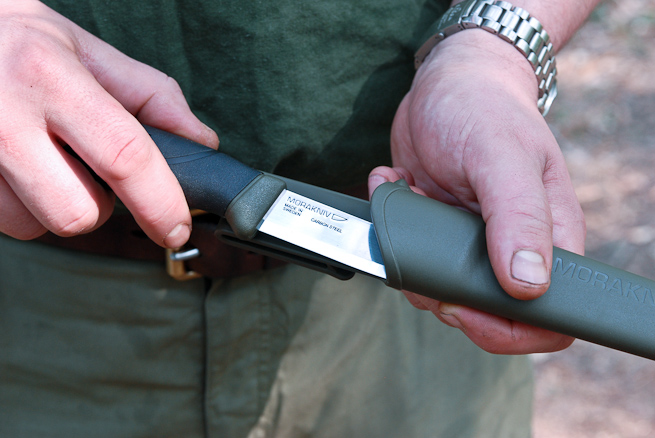

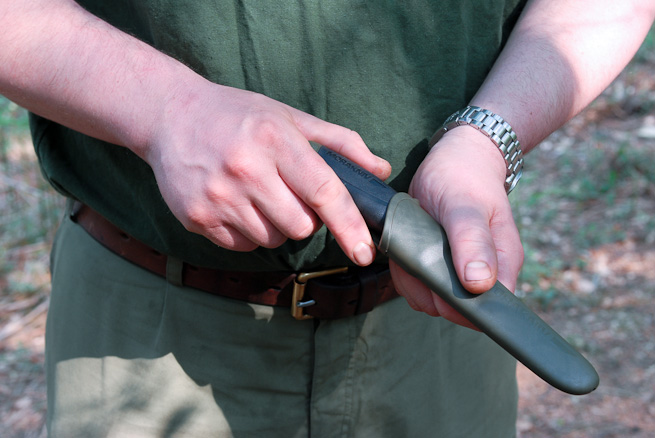
When you are not using your knife, put it back in the sheath
The safest place for your knife is in its sheath. Don’t be tempted to stick it in a log or a tree stump for a few minutes or otherwise leave it lying around.
With plenty of potential trip hazards outdoors, replace your knife in its sheath before walking even a short distance. You could cause yourself or others serious injury if you fall with a knife in your hand.
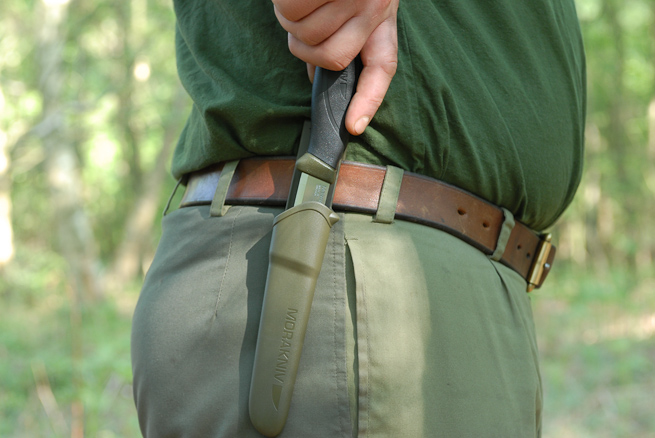
The only exception to this rule is if you have been using your knife to prepare raw meat or fish. Clean your knife before returning it to its sheath. Anticipate the need to clean your knife and have cleaning materials ready nearby.
Give yourself and others room
Don’t try to use your knife in awkward or confined spaces. Give yourself enough room to use it properly.
When using your knife, leave enough room around you so that you don’t endanger other people. If someone is within an arm’s reach, they are too close.
Be aware
If you are using a knife, be aware of the movement of other people around you. They may not have noticed you are using a knife.
Be aware of others using knives. If someone is using a knife nearby, stay at a safe distance.
Concentrate on what you are doing
Many cuts are due to a lack of concentration, either due to distractions or tiredness. If you aren’t able to concentrate, put your knife away until you can.
Hold your knife securely
The grip used most of the time is the forehand grip. It allows for powerful, safe cuts.
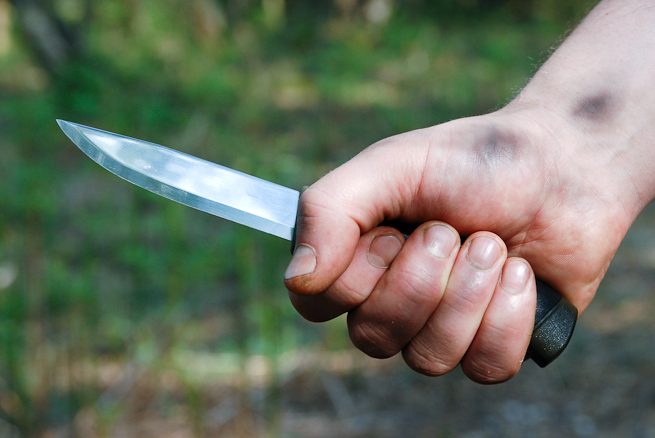
Cut away from yourself
Cut away from your body and cut away from your limbs. Pay particular attention to the position of the hand that is not holding the knife.
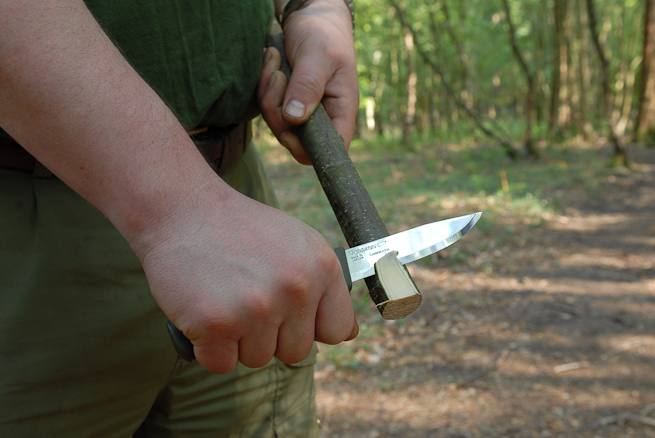
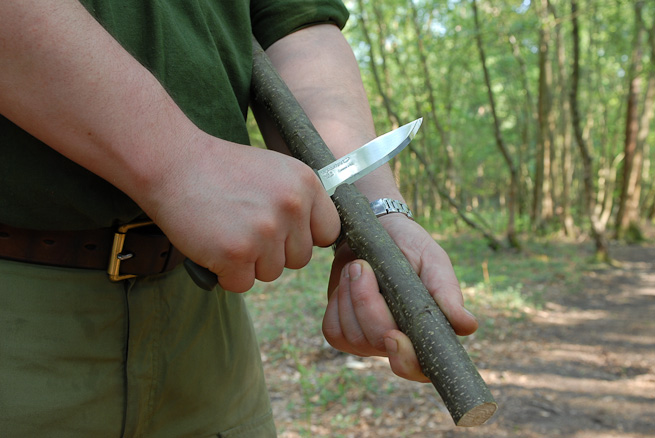
Don’t be overambitious
Even with a sharp knife, shave off modest amounts of material with each cut of the knife. Trying to remove too much material with each cut will require excessive force, causing tired hand muscles and reduced control of the knife.
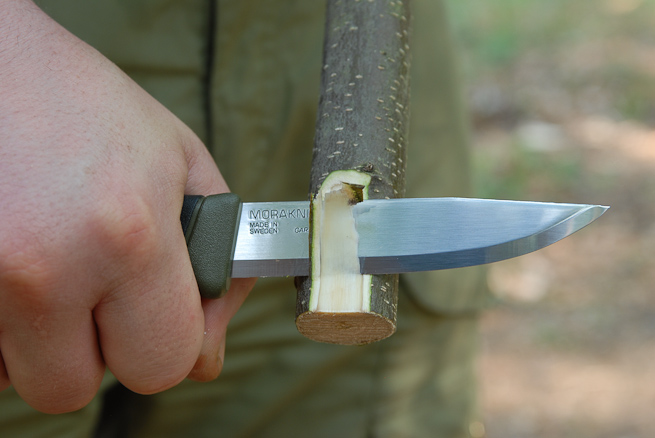
If you need more power, work on the outside of your body and generate power by dropping your shoulder.
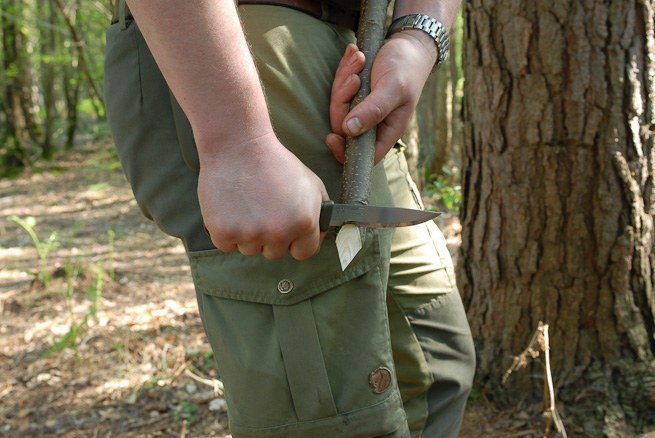
If you need more stability, work onto a log, tree stump or chopping block.
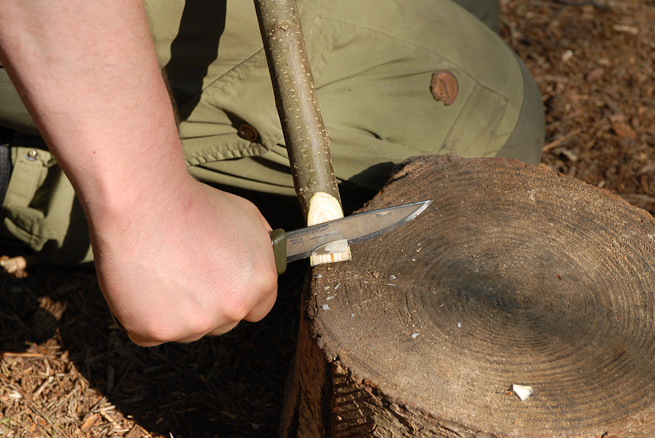
Elbows on knees
Cutting the major artery on the inside of your leg is potentially fatal. Take special care not to use a knife in a way that risks this. A particular concern is carving while sitting down. Keeping your elbows on your knees, prevents the knife coming close to your leg.

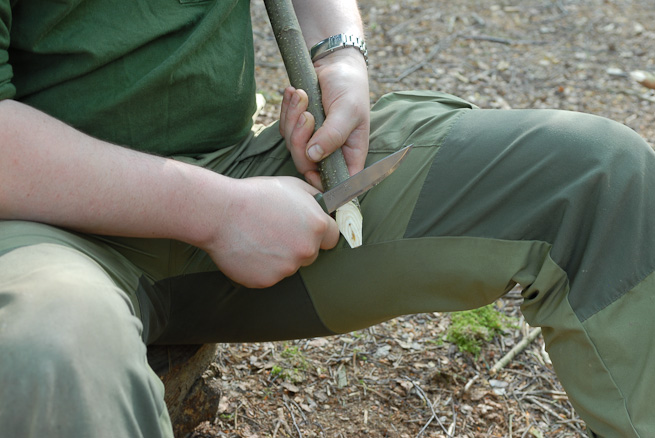

Think about where the knife will go if you slip
For every cut you make with your knife, consider where it will go next – not only if things go to plan but also if you slip or if you cut straight through what you are working on. Position yourself so that the next thing your knife hits isn’t you.
Listen to the little voice in your head
If you feel like you are using your knife in a risky or foolish way, then you probably are. Listen to the little voice in your head that tells you so. Then alter what you are doing so that it is safe. If you can’t figure out a way of safely achieving what you would like, ask someone with more experience for help.
How to pass a knife safely
If you need to pass a knife to someone, pass it in a way that does not put you or them at risk. Here’s how:
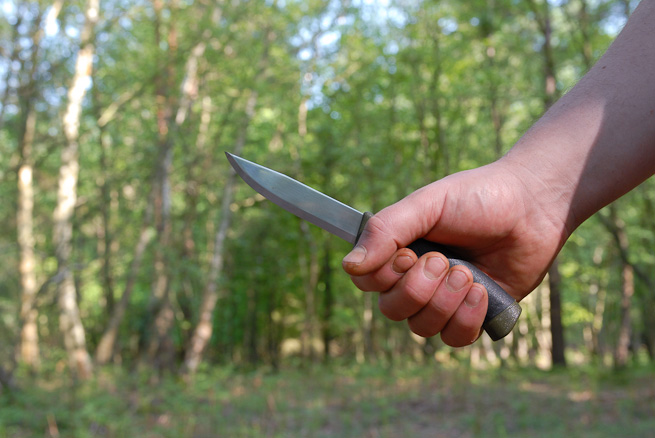

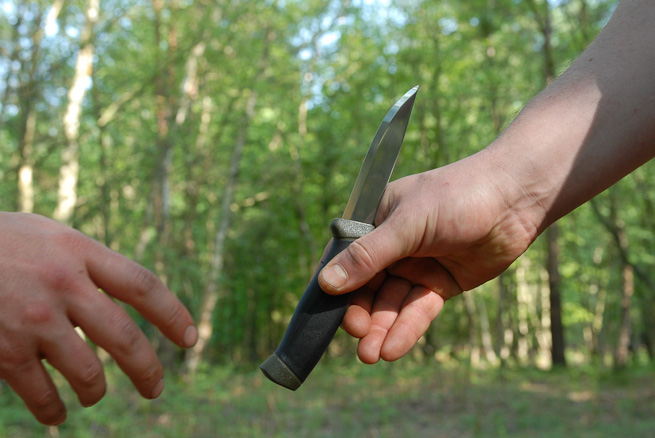
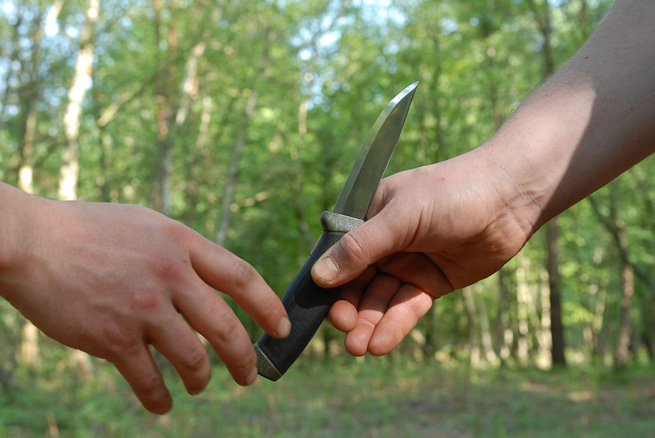
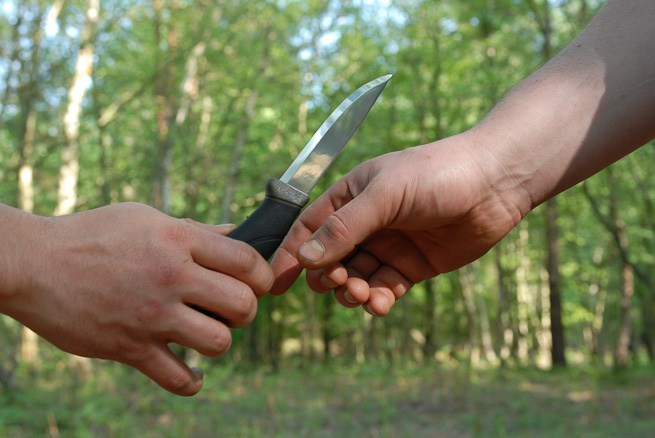
Pick up a cuts kit
If you use a knife often you will likely incur a few minor nicks. Having a small first aid kit on your person will help patch up and cuts and prevent infection.
Keep your knife sharp
A sharp knife is a safe knife. A sharp knife is predictable. You don’t need to apply excessive force when making a cut. If the knife is sharp, it cuts in a familiar way and you easily achieve what you need to. For more about sharpening see the additional resources below.
Stick to the rules
Above is laid out a straightforward set of rules for knife safety. If you apply them each time you pick up a knife, you will significantly reduce the chances of a serious cut.
Even if you are an experienced knife user, however, you should never become complacent. Having cut myself many times over the years, particularly when I was young, as well as having taught thousands of people knife techniques over the years, I am more conscious of the importance of applying these rules than ever.
Additional Resources
How To Sharpen A Bushcraft Knife
Can I Use A Lock Knife For Bushcraft?
Latest posts by Paul Kirtley (see all)
- The Swedish Firesteel - January 5, 2023
- Kevin Callan and Paul Kirtley in Conversation - April 25, 2020
- Kevin Callan and Ray Goodwin in Conversation - April 18, 2020

Roy Henshall
Great stuff to learn, better than learning the hard way and getting cut.
All bushcrafters should learn knife safety first as a must.
Paul Kirtley
Cheers Hedgey.
Indeed, most of the bad cuts I’ve ever seen have been when someone ignores one of these simple rules.
All the best,
Paul
Terry Halls
Hi Paul,
As always, a very clear and concise article with good photos and lots of tips! I tend to work with children and teenagers, so I still avoid the ‘elbows on knees’ position as I find that people tend to slip back to the less safe ‘between thighs’ position.
Thanks again,
Terry
Paul Kirtley
Hi Terry,
Thanks, it’s good to hear from you.
Good point regarding hands-on-knees for young people. Some adults need just as much reminding though 🙂
Cheers,
Paul
Frank
Greetings
Where can I attend in an in- person bushcrafters safety course in the east coast – NJ area ?
Thanks
Bodge
Hi Paul,
Again, a great informative tutorial. I always advise and practice ‘elbows on knees’ and am glad you have participated in the new Haynes manual. Good for you!
Paul Kirtley
Hi Bodge,
Thanks for your comment mate. Glad you liked this and thanks for your support!
Cheers,
Paul
Simon Wearn
A really great tutorial perfect for when I start my forest schools training look forward to more informative tutorials keep up the good work.
Best Wishes
Simon
Paul Kirtley
Hi Simon.
Thanks for your comment and kind feedback. I’m glad this will be useful to you.
Good luck with your Forest School training.
Warm regards,
Paul
Mike W
Paul
Great article, if it’s ok with you I will link to it from our Scout website and get all our scouts to view it before we start our ‘basic bushcraft’ programme after Easter
There are several of your articles I want to link to, such as knife sharpening
Keep up the good work
Mike
Anika Tulip
Thanks for this guide! I’m still learning about Knife safety and choosing the right knife. There’s so much information and varying opinions out there, thanks for presenting the facts and helping me to get a clear understanding of what I should be thinking about and considering for my Knives purchase.Thanks again and keep up the good work.This is a reasonable and brief article with great photographs and loads of tips! I have a tendency to work with youngsters and young people, so despite everything I evade the ‘elbows on knees’ position as I find that individuals have a tendency to slip back to the less safe ‘between thighs’ position.
Southp4w
The most cuts I have witnessed were due to cleaning a sharp knife with quick movements. Always be extra careful cleaning a sharp blade and make slow movements with the blade pointed away.
Wolfmaan
This is a great article! Cheers for posting! When we do our basic bushcraft course, we teach an almost identical method for people ages 6 to 60+
Bart
Thanx Paul!
Jock Campbell
Surprised you didn’t include the chest pull among these skills.
I find that technique the best for control and safety.
Paul Kirtley
Hi Steve, thanks for your comments.
This should provide some pointers: https://frontierbushcraft.com/2012/06/08/getting-started-bushcraft-equipment/
Warm regards,
Paul
Paul Kirtley
Thank you.